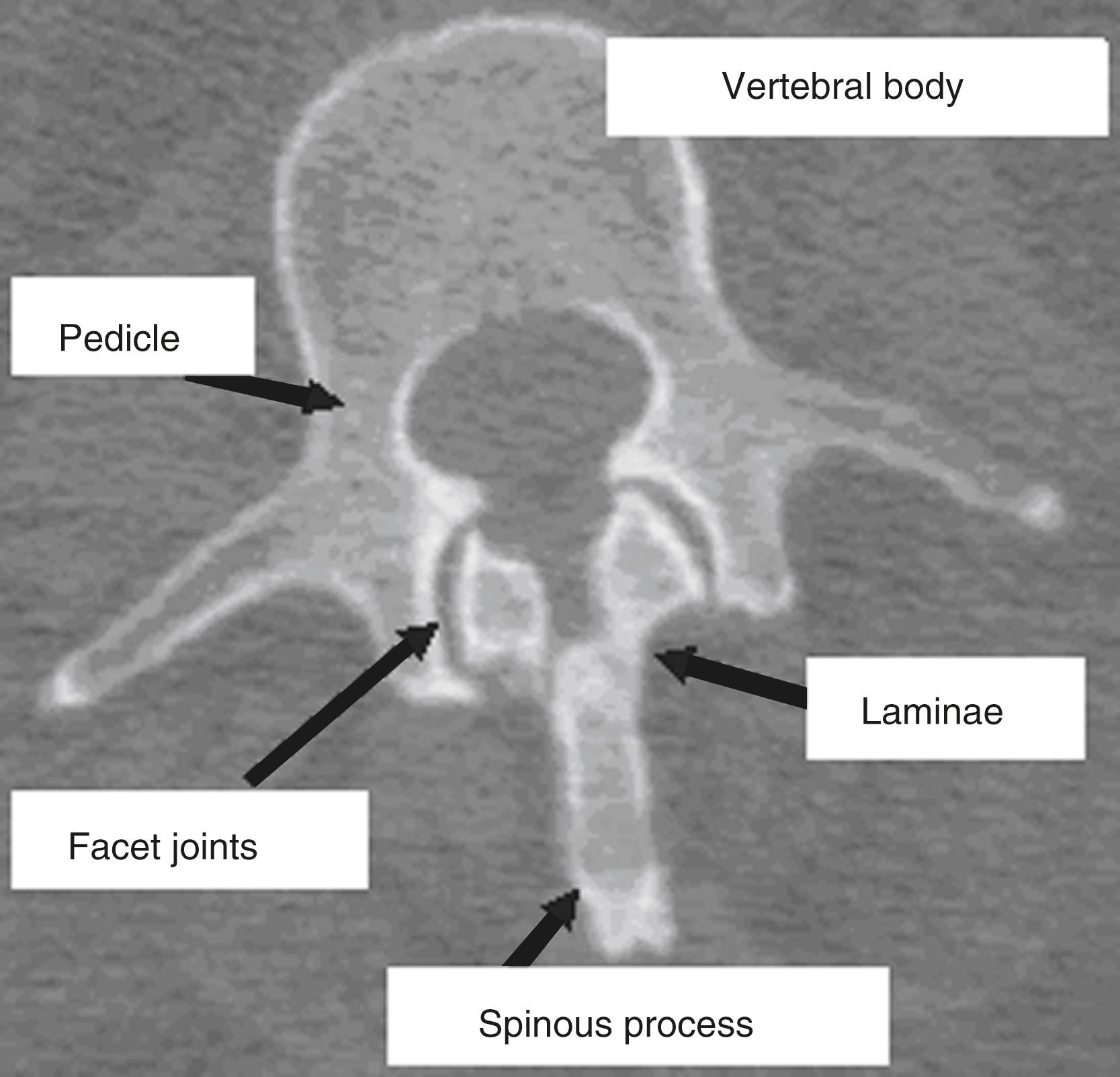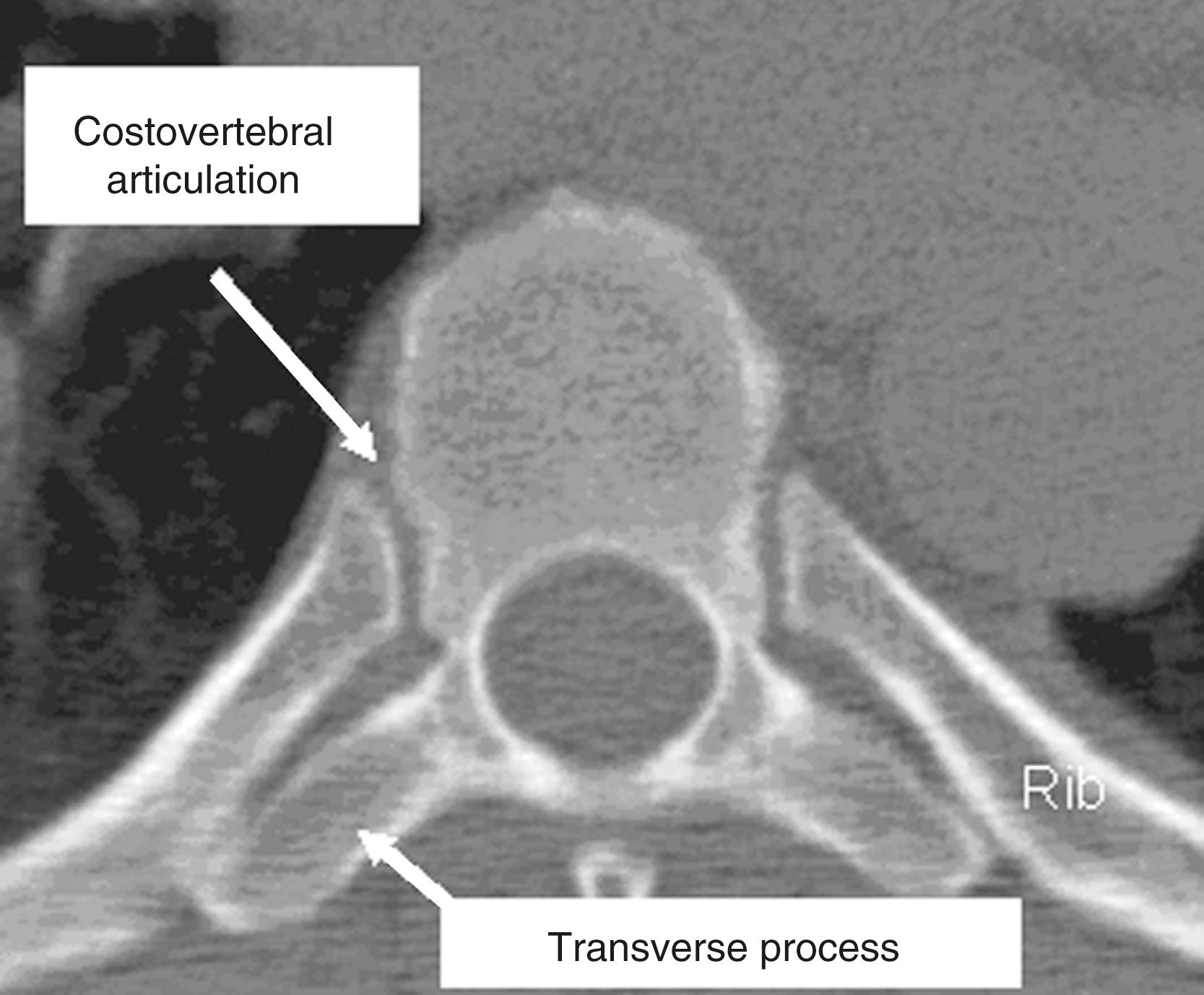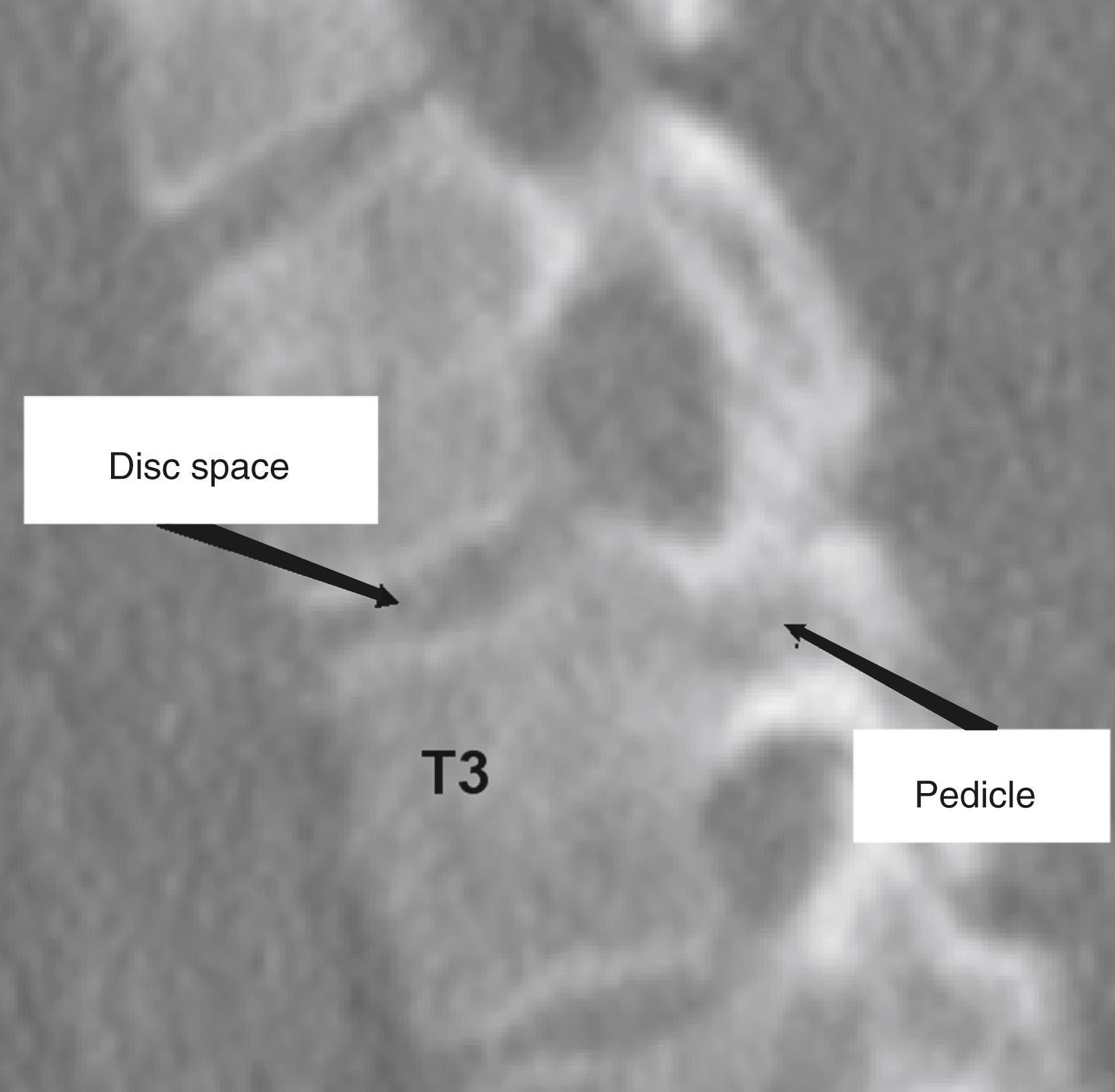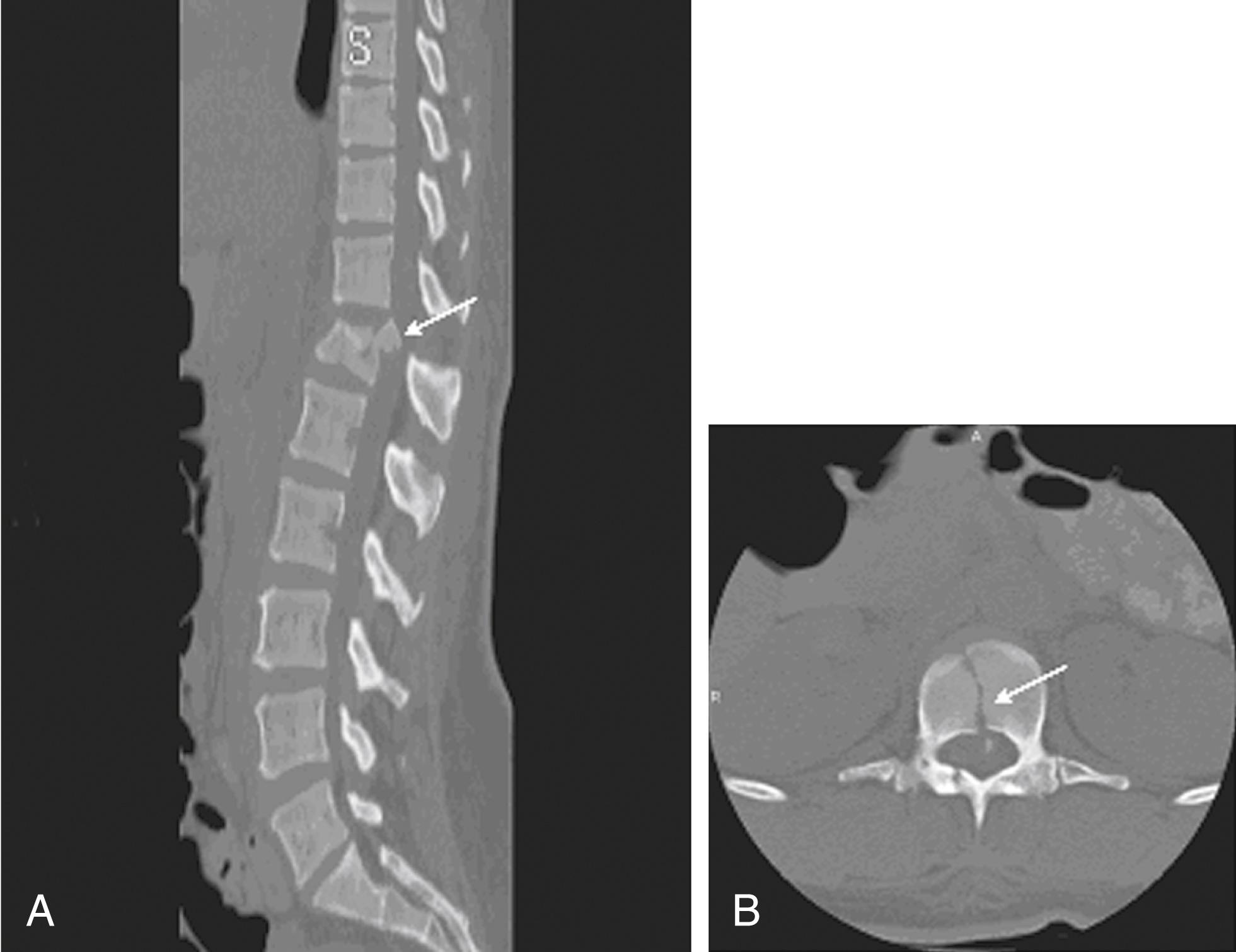Physical Address
304 North Cardinal St.
Dorchester Center, MA 02124
At the thoracolumbar spine, a long and stiff kyphotic thoracic spine converts abruptly into a mobile lordotic lumbar spine, and this transition zone is susceptible to injury.
All suspected spine trauma patients should be immobilized from the place of injury until a thorough and detailed evaluation can be performed.
The instantaneous axis of rotation is located in the ventral vertebral body in the thoracic spine and at the thoracolumbar junction.
The Thoracolumbar Injury Classification and Severity Scale aids in decision-making and has shown excellent intraobserver and interobserver reliability.
The AOSpine Classification System is based on the morphological feature of the fracture, neurological status of the patient, and patient-related comorbidities.
Single-column injuries are stable and can be managed nonoperatively, unless excessive kyphosis is noted.
In two-column injuries, if neurologically intact, a thoracolumbar sacral orthosis brace and continued close monitoring for worsening kyphosis and neurological examination are recommended.
Burst fracture with posterior tension band disruption is an indication for stabilization surgery with or without decompression.
Data on minimally invasive approaches to burst fractures are still limited and lower impact, but show reduced operative times, reduced blood loss, and shorter hospital lengths of stay when compared with open procedures.
Choice of surgery depends on neurological status and mode of compression; a ventral approach is used for decompressing midline ventral lesions and correcting severe kyphosis.
The authors would like to thank Drs. Alexander Vaccaro and Ravi Madineni for their past efforts in helping to shape this chapter into what it is today.
Approximately 160,000 patients a year in the United States suffer traumatic spinal column injuries, with 10% to 30% of them having a concurrent spinal cord injury. The majority of these injuries consist of cervical and lumbar (L3‒L5) spine fractures. However, between 15% and 20% of traumatic fractures occur at the thoracolumbar junction (T11‒L2), whereas 9% to 16% occur in the thoracic spine (T1‒T10). , Forces along the long stiff, kyphotic thoracic spine catalyze an abrupt switch into the mobile lordotic lumbar spine at the thoracolumbar junction. Biomechanically, this transition zone is susceptible to injury and is the most commonly injured portion of the spine. High-energy trauma (i.e., motor vehicle accidents) is the leading cause of injury over this region, followed by falls and sports-related injuries. Men are at a four times higher risk than women. Because of the higher-energy mechanisms of injury, involvement of other organ systems is encountered in up to 50% of thoracolumbar trauma patients. These high-energy injuries, such as those causing thoracic-level paraplegia, have a first-year mortality rate of 7%. ,
Thoracic spine and thoracolumbar junction trauma, as a result of regional anatomy and biomechanical characteristics, is categorized according to radiographic presentation, biomechanical deficiencies, and clinical presentation of the patient. Primary goals in thoracolumbar trauma patients are prompt recognition and treatment of associated injuries, expeditious stabilization of the spine, and protection of the neural elements.
The vertebral column provides humans with the ability to maintain an upright posture, protects the neural and visceral organs (i.e., heart, lungs, abdominal contents), and helps with motility. It consists of 29 vertebrae arranged in four major curves: two primary curves (thoracic and sacral), and two compensatory or secondary curves (cervical and lumbar). The vertebral column also provides a protective environment for the spinal cord and neural elements. The vertebral body, pedicles, and dorsal elements surround the spinal cord, permitting the spinal nerves to exit through the paired neural foramina. The laminae are formed as dorsomedial extensions of the pedicles and fuse in the midline to create the spinous processes ( Fig. 167.1 ). Nomenclature for the thoracic spine varies; however, in this chapter the thoracic spine is considered to span T1 through T10, and the thoracolumbar junction T11 through L3.

Primary spinal curves are present at birth, are maintained through life, and are relatively rigid or stiff. Secondary curves are more flexible and result from development or adaptation. The first secondary curve is the development of cervical lordosis at approximately 3 to 9 months of age as the infant begins supporting his or her head and sitting upright. The lumbar lordosis develops later (between 12 and 18 months), as the child begins to ambulate and assumes an upright posture. A thorough knowledge of the thoracic spine and thoracolumbar junction anatomy facilitates a greater understanding of the biomechanical, radiographic, and surgical techniques that are used to treat these fractures.
The thoracic spine differs from the cervical and lumbosacral spines as a result of its articulation with the rib cage (T1‒T12), extensive ligamentous support network, coronal facet joint orientation, and small spinal canal-to-neural element ratio ( Fig. 167.2 ). The thoracic laminae increase in width and thickness from T1 to T12, and this prevents hyperextension. The anterior longitudinal ligament (ALL) provides further stability by increasing the tensile strength from T1 to T12. Moreover, the dorsal, ventral, and lateral diameters of the vertebral bodies increase from T2 to T12. The thoracic kyphotic curve results from the greater height of the dorsal vertebral wall as opposed to the ventral vertebral wall. The transverse pedicle diameters decrease from 9 mm at T1 to 5 mm at T5 and then increase in size distally to T12. In the sagittal plane, pedicle width increases from T1 to T11. However, in the transverse or axial plane, the thoracic vertebrae have a triangular configuration and appear heart shaped. There is significant variability in what is considered the “normal” sagittal curvature of the thoracic spine. This value has been reported to be between 20 and 45 degrees, , , with each individual vertebral body contributing approximately 3.8 to 3.9 degrees of kyphosis through its wedged-shaped angulation. This variability is further influenced by age (increases with age) and sex; women have a greater degree of kyphosis than men. , There is also a significant degree of variability on a segmental basis, particularly at the transitional regions with the lordotic cervical and lumbar spines. , , The apex of thoracic kyphosis is typically located at the seventh thoracic vertebra, but varies with each individual. The thoracic spine typically has a mild, right-sided lateral curvature. , The etiology of the right-sided lateral curve is debated, but is believed to either result from hand dominance (right-hand majority) or be created by pulsations of the thoracic aorta.

The thoracic pedicles are situated toward the rostral portion of the vertebral body, close to the superior disc space ( Fig. 167.3 ). The pedicle angle decreases from T1 to T12; it is 251 degrees at T1 and 0 degrees at T12. , , The pedicle location on the vertebral body progressively migrates as the spine is descended in a caudal direction. The medial pedicle cortical wall is approximately two to three times thicker than the lateral wall.

The thoracic transverse processes project laterally from the dorsal articular pillars and decrease in length caudally. However, unlike the lumbar spine, the relationship between the transverse process and the midpoint of the pedicle is not as clearly defined. McCormick showed that there is a significant degree of variability in the relationship of the transverse processes to the pedicles. The midpoint of the T1 transverse process is approximately 5 mm rostral to the center of the pedicle, whereas at T12 the transverse process–to-pedicle relationship changes to approximately 6 mm caudal. Comparatively, this transverse process–to-pedicle relationship is greater than 1 cm at both T1 and T2, and it is approximately 0 cm when one analyzes T6 and T7.
The thoracic spine facet articulations are considered apophyseal joints and are composed of a ligamentous capsule with a synovial lining. These ligaments in the thoracic spine are thicker than their cervical counterparts. In the thoracic spine, the costovertebral (rib–vertebra) facets are located anterior to the transverse processes. The isthmus of bone between each pair of superior and inferior facets is called the pars interarticularis, a site of fracture and bony nonunion for those with a condition known as spondylolysis. The joints are located at the rostral and caudal borders of the laminae and situated medial to the transverse processes ( Fig. 167.4 ). The caudal facet’s ventral surface articulates with the rostral facet’s dorsal surface. Thoracic facet joints are oriented in a coronal plane and therefore limit the degree of flexion and extension of the thoracic spine.

There are several key anatomic features that are essential for understanding the relationship between the ribs and the thoracic vertebrae. First, the ribs articulate with the thoracic vertebrae at two separate locations. The head of the rib articulates with the transverse process of the body at the costotransverse articulation, except at T1, T11, and T12. This articulation is supported with a large superior costotransverse ligament, which connects the rostral rib segment to the caudal transverse process (see Fig. 167.2 ). It also articulates with the disc space adjacent to the body above by virtue of the rib head of the same-numbered vertebral body articulating with it through the two costal hemifacets (T2‒T10).
The strong ligamentous structures that compose the costovertebral joint make the thoracic disc the strongest of all the vertebral discs. The superior hemifacet (rostral on the vertebral body and caudal to the rib) is located over the pedicle, such that the sixth rib articulates with the fifth and sixth thoracic vertebral bodies and overlies the sixth vertebral pedicle. Because of the rostral location of the thoracic pedicle on the vertebral body, the sixth rib overlies the T5‒T6 disc space. Understanding the anatomic relationship of the rib head with the pedicle allows the surgeon to remove the rib head and identify the neurovascular bundle, along with the neural foramina and thecal sac, at that level.
The spinal canal diameter varies throughout the vertebral column and is the narrowest in the midthoracic region (T3‒T9). , , The transverse spinal canal diameter decreases from T1 to T3 and then increases caudally into the lumbar region. The anteroposterior (AP) diameter, however, is more varied. , Therefore, in the thoracic region a minor degree of canal encroachment can compromise the narrow canal and may result in neurological compromise. , Furthermore, the thoracic spinal cord has the most tenuous blood supply. Thus, small canal size, limited blood supply, and the high degree of energy required to create a thoracic fracture combine to result in a 90% incidence of neurological deficit in patients who sustain a thoracic fracture.
The transition from a relatively rigid thoracic kyphosis to a mobile lumbar spine occurs at the thoracolumbar junction. This transition generally occurs at T11‒T12, although in elderly female patients the thoracolumbar inflexion point migrates caudally as a result of their increased degree of thoracic kyphosis. , ,
The caudal thoracic ribs (T11 and T12) afford less stability at the thoracolumbar junction region compared with the rostral thoracic region because there is no connection to the sternum, and thus they are “free-floating.” Only a single rib articulation is present on the T11 and T12 vertebral bodies, and there are no accessory ligamentous attachments, such as the rib’s tubercle to the vertebral body by the costotransverse ligament, or the ligamentous attachment to the transverse process. The surrounding thoracolumbar ligaments, such as the interspinous and thoracolumbar fascia, are strongest caudally and provide a significant amount of stability.
The thoracolumbar junction facet joints are again of the apophyseal type and are composed of a ligamentous capsule with a synovial lining. As mentioned previously, the joints of the midthoracic region are oriented in the coronal plane, limiting flexion and extension while providing substantial resistance to AP translation. In the lumbosacral region, the facet joints are oriented in a more sagittal alignment, which increases the degree of potential flexion and extension at the expense of limiting lateral bending and rotation. Depending on the spatial orientation of the spinal column (i.e., flexion or extension), the facet joints may support a third of the axial load. These joints, however, provide substantial support and resistance to approximately 35% to 45% of the torsional and shear forces experienced in this region. ,
At birth, the spinal cord terminates at the end of the vertebral column or lumbosacral junction. However, the end of the spinal cord, or conus medullaris, migrates rostrally as the infant develops. In neonates the spinal cord terminates between the first and third lumbar vertebrae, whereas in adults it is positioned between the twelfth thoracic vertebra and the second lumbar vertebra.
It is not uncommon in clinically unstable trauma patients for fractures not to be identified early in the resuscitative period. It has been reported that between 5% and 15% of multisystem trauma patients have occult fractures not diagnosed on their initial evaluation. Although thoracic vertebral fractures make up only a minor proportion of traumatic fractures, they are extremely difficult to visualize compared with other vertebral or appendicular fractures. Approximately 20% to 50% of superior thoracic spine fractures are not diagnosed on admission plain radiographs. , , Therefore, all suspected spine trauma patients should be immobilized on admission until a thorough and detailed spinal evaluation can be performed. If appropriate stabilization precautions are not taken in this patient population, unforeseen neurological compromise may result.
Initial radiographic assessment includes AP and lateral spine films. The AP film should be examined for loss of vertical body height, fracture of the oval-shaped pedicles, increased interpedicular distance, transverse process or rib fractures, and malalignment of vertebral bodies or spinous processes without a history of scoliosis. The lateral radiograph should be examined for loss of body height, disruption of the rostral or caudal end plate, dorsal cortical wall fracture with retropulsed bone, fracture of spinous processes, widening of interspinous distance, and subluxation or angulation of vertebral bodies. Malalignment in any plane, but especially in the AP plane, suggests the possibility of a fracture dislocation. Plain radiographs may not be accurate in determining the involvement of the posterior vertebral wall with a thoracic fracture. ,
Plain radiographs are particularly useful in assessing the patient’s overall sagittal and coronal balance. If a deformity exists, a useful radiographic technique to determine the degree of deformity is measurement of the Cobb angle, which is the subtended angle measured between a perpendicular line drawn from the superior end plate of the vertebral body above the injured vertebral body and the inferior end plate one level below the injured body (see Fig. 167.20 , presented later in the chapter). This method of measuring spinal sagittal angulation has been shown to be associated with the highest degree of intraobserver and interobserver reliability. ,
In the presence of a vertebral body injury, the entire spine should be imaged in an orthogonal manner because of the high incidence (5% to 20%) of noncontiguous spine fractures. The rostral thoracic spine can be difficult to visualize on lateral plain radiographs because of the patient’s shoulders and body habitus, and a swimmer’s view may provide better visualization of the cervicothoracic junction down to the T3 vertebral body. Radiographically, a typical superior end plate thoracic fracture shows loss of vertebral height, with or without malalignment, a widened paraspinal line, and possibly a widened mediastinum. Because of difficulties in imaging the upper thoracic region (T1‒T4), a high index of suspicion is required on the physician’s part to avoid missing injuries at this level. The physician should have a low threshold for ordering supplemental imaging modalities to assist in the diagnosis, such as computed tomography (CT) and magnetic resonance imaging (MRI).
CT is more sensitive in detecting fractures than plain radiographs (see Fig. 167.4 ). Helical CT reconstruction detects 99% of all thoracolumbar fractures, whereas plain radiographs detect 87%. It can also define the three-dimensional anatomy of complex fractures through reformatting in the sagittal and coronal planes. CT better delineates the bony structures once an injury is identified. CT reveals the integrity of the middle column and the degree of canal compromise, as well as subluxations or fractures of superior and inferior articular processes and laminae. The presence of two vertebral bodies on the same axial cut of a CT scan may indicate a fracture dislocation, but first the radiographer must ensure that the gantry has been angled parallel to the vertebral end plates. Sagittal reconstructions are helpful in visualizing flexion-distraction injuries and fracture dislocations. Serial CT scans of lumbar fractures have confirmed spontaneous remodeling and the reabsorption of retropulsed bone fragments in the spinal canal at long-term follow-up.
CT image reconstruction is also invaluable at the cervicothoracic junction because of the overlap of the scapula, shoulders, and surrounding tissues. In the obtunded patient, this technique has been reported to identify more than 10% of fractures not visualized on plain radiographs. CT, however, has a limited capacity to visualize disc herniations, epidural or subdural hematomas, ligamentous disruption, and spinal cord parenchymal changes.
Become a Clinical Tree membership for Full access and enjoy Unlimited articles
If you are a member. Log in here